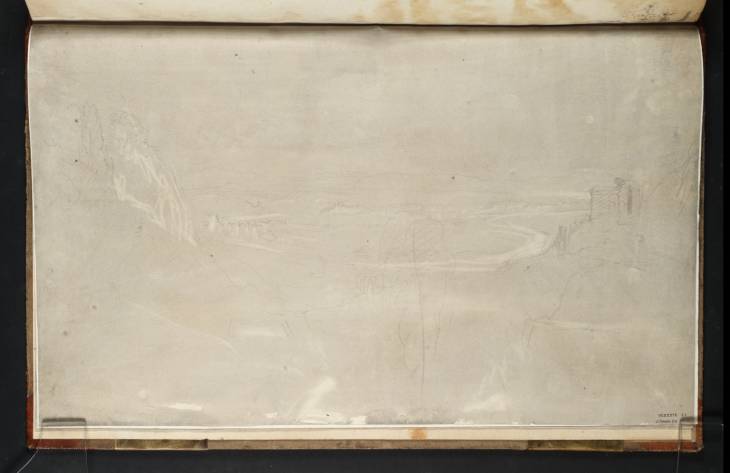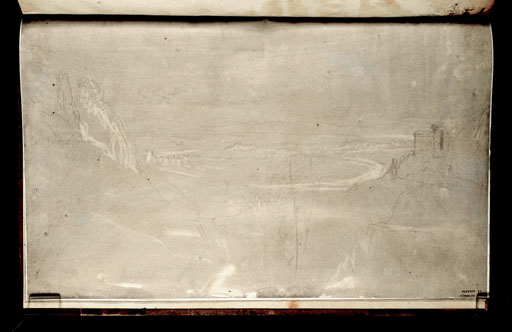Joseph Mallord William Turner View of Ponte Molle and the River Tiber, Rome, from Monte Mario 1819
Image 1 of 2
Joseph Mallord William Turner,
View of Ponte Molle and the River Tiber, Rome, from Monte Mario
1819
Joseph Mallord William Turner 1775–1851
Folio 60 Recto:
View of Ponte Molle and the River Tiber, Rome, from Monte Mario 1819
D16391
Turner Bequest CLXXXIX 60
Turner Bequest CLXXXIX 60
Pencil and grey watercolour wash on white wove ‘Valleyfield’ paper, 229 x 368 mm
Inscribed by an unknown hand in pencil ‘CLXXXIX’ and with traces of red ink bottom right
Stamped in black ‘CLXXXIX 60’ bottom right
Inscribed by an unknown hand in pencil ‘CLXXXIX’ and with traces of red ink bottom right
Stamped in black ‘CLXXXIX 60’ bottom right
Accepted by the nation as part of the Turner Bequest 1856
References
1909
A.J. Finberg, A Complete Inventory of the Drawings of the Turner Bequest, London 1909, vol.I, p.564, as ‘Rome, from Monte Mario, with Ponte Molle in mid-distance.’.
1979
Andrew Wilton, The Life and Work of J.M.W. Turner, Fribourg 1979, p.383 under no.719.
2000
Eric Shanes, Evelyn Joll, Ian Warrell and others, Turner: The Great Watercolours, exhibition catalogue, Royal Academy of Arts, London 2000, p.145 under no.52.
Some of the most famous panoramas of Rome could be seen from the heights of Monte Mario, a hill to the north of the city. John Chetwode Eustace, author of A Classical Tour in Italy described the view from the Villa Mellini (now the Rome Observatory) on the summit of the hill:
The Tiber intersecting the city and winding through rich meadows; the Prata Quintia and Prata Mutia, fields still bearing their names, the trophies of Roman virtue and Roman heroism; the Pons Milvius with its tower, and the plains consecrated by the victory of Constantine; the Vatican Palace with its courts and gardens; the Basilica of St Peter with its portico, its obelisk, and its fountains, the Campus Martius covered with the churches, squares and palaces of the modern city; the seven hills strewed with ruins of the ancient; the walls with their towers and galleries; the desert Campagna, with Mount Soracte rising apparently in the centre; and the semi-circular sweep of mountains tinged with blue or purple, now bright with the sun, now dark in the shade, and generally gleaming with snow – such is the varied and magnificent scene spread out before the traveller, while reposing on the shaded terrace of Villa Mellini.1
This composition encompasses a sweep of approximately ninety degrees with the central focus being the dramatic ox-bow curve of the River Tiber in the foreground. As Finberg first identified, the bridge on the left is the Ponte Molle, also known as the Ponte Milvio. This crossing carried the Via Flaminia across the Tiber into Rome and hence was the entry and exit point for British tourists to and from the city during the nineteenth century. Famous as the site of the deciding battle between Emperors Constantine and Maxentius in 312 AD, the bridge is recognisable from the four central arches spanning the river (there were also two smaller arches at either end not clearly visible from a distance) and an entrance tower on the northern end (left) which had been rebuilt in 1805.2 The building visible on the far right-hand side meanwhile is the Villa Madama, a sixteenth-century estate built for the Medici family on the eastern slopes, famous for its garden loggia designed by Raphael.3 Like many pages within this sketchbook, the drawing has been executed over a washed grey background. Turner has created areas of pale highlights by lifting or rubbing through to the white paper beneath, principally to delineate the twisting course of the river.
Turner made a significant number of studies repeating related views from the Villa Madama and Monte Mario, see folios 31, 48 and 57 (D16357, D16377, D16388) and loose sheets (D16342, D16350, D16352; CLXXXIX 16, 24, 26). Further sketches can also be found in the St Peter’s sketchbook (Tate D16174–D16177; Turner Bequest CLXXXVIII 9a–11) and the Small Roman C. Studies sketchbook (Tate D16444; CXC 33a). The large number of drawings devoted to the subject suggests that he was seriously exploring the idea as a potential theme for a painting. Indeed, the visual motif of the sweeping bend of river appears in a later oil study, Hill Town on the Edge of the Campagna ?1828 (Tate, N05526).4 The composition is also very similar to James Hakewill’s drawing of the same subject, View of the Ponte Molle and the Tiber, Looking across the Campagna to the Sabine Mountains 1816.5
For a detailed sketch of the bridge prior to 1805 see William Marlow (1740–1813), Ponte Molle, pencil on paper, Tate T09173.
Martin Butlin and Evelyn Joll, The Paintings of J.M.W. Turner, revised ed., New Haven and London 1984, no.318.
Verso:
Blank except for traces of watercolour.
Nicola Moorby
July 2009
How to cite
Nicola Moorby, ‘View of Ponte Molle and the River Tiber, Rome, from Monte Mario 1819 by Joseph Mallord William Turner’, catalogue entry, July 2009, in David Blayney Brown (ed.), J.M.W. Turner: Sketchbooks, Drawings and Watercolours, Tate Research Publication, December 2012, https://www


